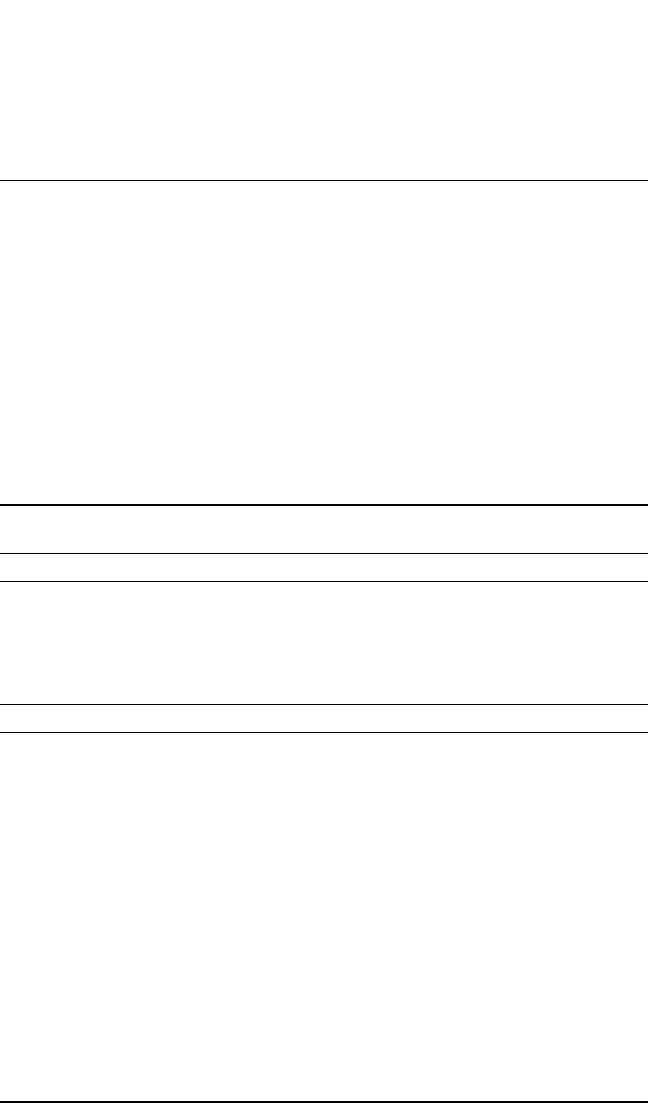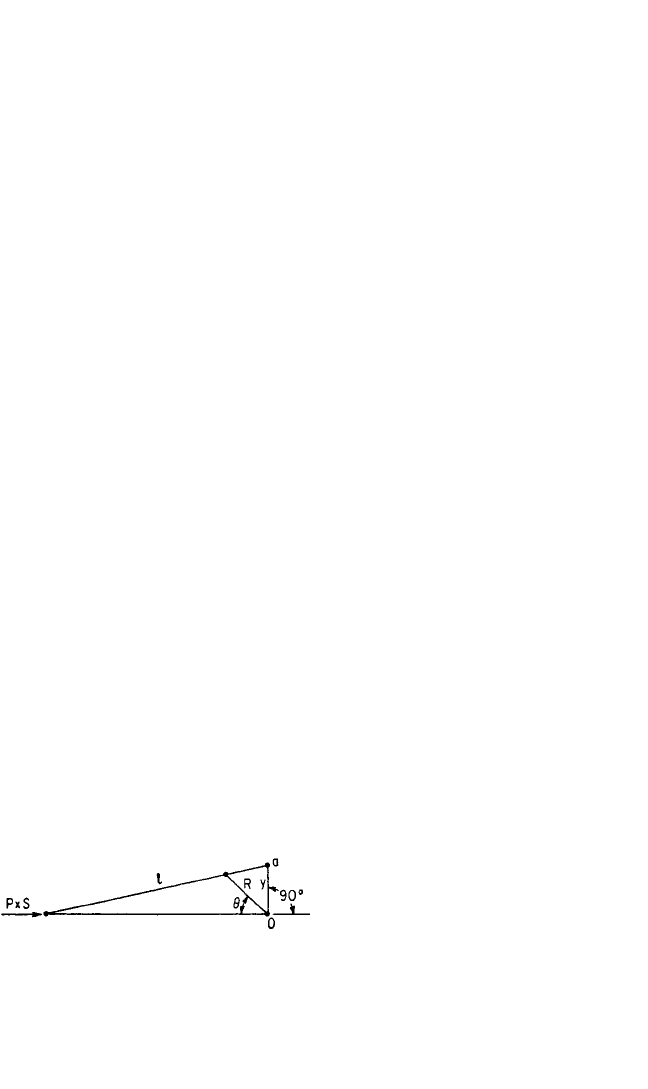Harris C.M., Piersol A.G. Harris Shock and vibration handbook
Подождите немного. Документ загружается.


causing the vibration. Vibration amplitudes and stresses around the operating range
and at the critical speeds must be calculated. A study of remedial measures is also
necessary.
VIBRATORY TORQUES
Torsional vibration, like any other type of vibration, results from a source of excita-
tion. The mechanisms that introduce torsional vibration into a machine system are
discussed and quantified in this section. The principal sources of the vibratory
torques that cause torsional vibration are engines, pumps, propellers, and electric
motors.
GENERAL EXCITATION
Table 38.2 shows some ways by which torsional vibration can be excited. Most of
these sources are related to the work done by the machine and thus cannot be
entirely removed. Many times, however, adjustments can be made during the design
TORSIONAL VIBRATION IN RECIPROCATING AND ROTATING MACHINES 38.15
TABLE 38.2 Sources of Excitation of Torsional Vibration
Amplitude in
Source terms of rated torque Frequency
Mechanical
Gear runout 1 ×,2 ×,3 × rpm
Gear tooth machining tolerances No. gear teeth × rpm
Coupling unbalance 1 × rpm
Hooke’s joint 2 ×,4 ×,6 × rpm
Coupling misalignment Dependent on drive
elements
System function
Synchronous motor start-up 5–10 2 × slip frequency
Variable-frequency induction motors 0.04–1.0 6 ×, 12 ×, 18 × line
(six-step adjustable frequency (LF)
frequency drive)
Induction motor start-up 3–10 Air gap induced at 60 Hz
Variable-frequency induction motor 0.01–0.2 5 ×,7 ×,9 × LF, etc.
(pulse width modulated)
Centrifugal pumps 0.10–0.4 No. vanes × rpm
and multiples
Reciprocating pumps No. plungers × rpm
and multiples
Compressors with vaned diffusers 0.03–1.0 No. vanes × rpm
Motor- or turbine-driven systems 0.05–1.0 No. poles or blades × rpm
Engine geared systems 0.15–0.3 Depends on engine design
with soft coupling and operating conditions;
can be 0.5n and n × rpm
Engine geared system 0.50 or more Depends on engine design
with stiff coupling and operating conditions
Shaft vibration n × rpm
8434_Harris_38_b.qxd 09/20/2001 12:26 PM Page 38.15

process. For example, certain construction and installation sources—gear runout,
unbalanced or misaligned couplings, and gear-tooth machining errors—can be
reduced.
In Table 38.2 note that the pulsating torque during start-up of a synchronous
motor is equal to twice the slip frequency. The slip frequency varies from twice the
line frequency at start-up to zero at synchronous speed. Many mechanical drives
exhibit characteristics of pulsating torque during operation due to their design func-
tion. Electric motors with variable-frequency drives induce pulsating torques at fre-
quencies that are harmonics of line frequency. Blade-passing excitations can be
characterized by the number of blades or vanes on the wheel:The frequency of exci-
tation equals the number of blades multiplied by shaft speed. The amplitude of a
pulsating torque is often given in terms of percentage of average torque generated
in a system.
ENGINE EXCITATION
In more complex cases, diesel gasoline engines for example, the multiple frequency
components depend on engine design and power output. The power output, crank-
shaft phasing, and relationship between gas torque and inertial torque influence the
level of torsional excitation.
Inertia Torque. A harmonic analysis of the inertia torque of a cylinder is closely
approximated by
1
M =Ω
2
r
sin − sin 2 −λsin 3 − sin 4 ⋅⋅⋅
(38.18)
where W = W
p
+ hW
c
[see Fig. 38.4 and Eq.(38.2)]
λ=R/l [see Fig. 38.4 and Eq. (38.2)]
Ω=angular speed, rad/sec
R = crank radius, in.
l = connecting rod length, in.
= crank angle, radians
W
p
= weight of piston, lb
W
c
= weight of connecting rod, lb
It is usual to drop all terms above the third order.
Gas-Pressure Torque. A harmonic
analysis of the turning effort curve yields
the gas-pressure components of the excit-
ing torque. The turning effort curve is
obtained from the indicator card of the
engine by the graphical construction
shown in Fig. 38.13.
For a given crank angle θ, let the gas
pressure on the piston be P. Erect a per-
pendicular to the line of action of the
piston from the crank center, intersect-
ing the line of the connecting rod. Let the intercept Oa on this perpendicular be y.
Then the torque M for angle θ is given by
λ
2
4
3
4
1
2
λ
4
W
g
38.16 CHAPTER THIRTY-EIGHT
FIGURE 38.13 Schematic diagram of crank
and connecting rod used in plotting torque
curve.
8434_Harris_38_b.qxd 09/20/2001 12:26 PM Page 38.16

M = PSy (38.19)
where S is the piston area. A gas pressure versus rotation curve analyzed to obtain
harmonic gas coefficients is required to conduct a gas-pressure torque calibration.
Harmonic gas coefficients are often available from engine manufacturers.
FORCED VIBRATION RESPONSE
The torsional vibration amplitude of a modeled system is determined by the magni-
tude, points of application, and phase relations of the exciting torques produced by
engine or compressor gas pressure and inertia and by the magnitudes and points of
application of the damping torques. Damping is attributable to a variety of sources,
including pumping action in the engine bearings, hysteresis in the shafting and
between fitted parts, and energy absorbed in the engine frame and foundation. In a
few cases, notably marine propellers, damping of the propeller predominates. When
an engine is fitted with a damper, the effects of damping dominate the torsional
vibrations.
Techniques available for calculation of vibration amplitudes include the exact
solution of differential equations, the energy balance method, the transfer matrix
method, and modal analysis. The techniques are implemented on lumped parameter
or finite-element models.
EXACT METHOD FOR TWO DEGREE-OF-FREEDOM SYSTEMS
The lowest mode of vibration of some systems, particularly marine installations, can
be approximated with a two-mass system; an excitation is applied at one end and
damping at the other.
Referring to Fig. 38.14, the torque equations for rotors I
1
and I
2
are
I
1
ω
2
θ
1
− k(θ
1
−θ
2
) + M
e
= 0
I
2
ω
2
θ
2
+ k(θ
1
−θ
2
) − jcωθ
2
= 0
The natural frequency is given by
ω
2
=
The shaft torque is M
12
= k(θ
1
−θ
2
). If the above equations are solved, the amplitude
of M
12
at resonance is
|M
12
| = k|θ
1
−θ
2
| = M
e
1 + (38.20)
Since with usual damping the second term under the radical is large compared with
unity, Eq. (38.20) reduces to
|M
12
|
(I
1
+ I
2
) (38.21)
I
2
k
I
1
I
2
I
1
M
e
c
kI
2
(I
1
+ I
2
)
I
1
c
2
I
2
I
1
k(I
1
+ I
2
)
I
1
I
2
TORSIONAL VIBRATION IN RECIPROCATING AND ROTATING MACHINES 38.17
8434_Harris_38_b.qxd 09/20/2001 12:26 PM Page 38.17

The torsional damping constant c of a marine propeller is a matter of some uncer-
tainty. It is customary to use the “steady-state” value. This is an approximation:
c = in.-lb/rad/sec
where Ω=angular speed of shaft in radi-
ans per second. Considerations of oscil-
lating airfoil theory indicate that this is
too high and that a better value would be
c = in.-lb/rad/sec (38.22)
Equation (38.21) is applicable only
when I
1
/I
2
> 1. If used outside this range
with other types of damping neglected,
fictitiously large amplitudes will be
obtained. Equation (38.21) gives the res-
onance amplitude, but the peak may not occur exactly at resonance. The complete
amplitude curve is computed by the methods discussed in the following section.
ENERGY BALANCE METHOD
Both rational and empirical formulas for the resonance amplitudes of systems with-
out dampers can be based on the energy balance at resonance. It is assumed that the
system vibrates in a normal mode and that the displacement is in a 90° phase rela-
tionship to the exciting and damping torques. The energy input by the exciting
torques is then equal to the energy output by the damping torques. Unless the damp-
ing is extremely large, this assumption gives a very close approximation to the ampli-
tude at resonance.
Figure 38.15 shows a curve of relative amplitude in the first mode of vibration.
Assume that a cylinder acts at A. Let the actual amplitude at A be θ
a
and the ampli-
tude relative to that of the No. 1 cylinder be β. The β values are taken from the col-
umn opposite each rotor number in the sequence calculation for the natural
frequency calculation. At a point such as B, where damping may be applied, let the
actual amplitude be θ
d
and the amplitude relative to the No. 1 cylinder be β
d
.
2.3M
mean
Ω
4M
mean
Ω
38.18 CHAPTER THIRTY-EIGHT
FIGURE 38.14 Schematic diagram of a shaft
with two rotors, showing positions of excitation
and damping.
FIGURE 38.15 Diagram of actual amplitude θ and relative amplitude β as a
function of position along shaft. Excitation is at A, and B is the position where
damping is applied. The No. 1 cylinder is at the free end of the crankshaft.
8434_Harris_38_b.qxd 09/20/2001 12:26 PM Page 38.18

The energy input to the system from the cylinder acting at A is
πM
e
θ
a
in.-lb/cycle
and the energy output to the damper is
πcωθ
d
2
in.-lb/cycle
where c* is the damping constant action of the damper at B. Equating input to
output,
M
e
θ
a
= cωθ
d
2
(38.23a)
Let θ′ be the amplitude at the No. 1 cylinder produced by the cylinder acting at A.
Then θ
e
/θ′ = β and θ
d
/θ′ = β
d
. Substituting in Eq. (38.23a) gives
θ′ = (38.23b)
If all the cylinders act, and if damping is applied at a variety of points, the total
amplitude at the No. 1 cylinder is
θ = Σθ′ = (38.24)
where Σβ is taken over the cylinders and Σcβ
d
2
is taken over the points at which
damping is applied. This formula can be applied directly when the magnitude and
points of application of the damping torques are known. For the great majority of
applications, where the damping is unknown, a number of empirical formulas have
been proposed with coefficients based on engine tests. These formulas may give an
amplitude varying 30 percent or more from test results if applied to a variety of
engines. Better agreement should not be expected, for even identical engines may
have amplitudes differing as much as 2 to 1, depending on length of service, bearing
fits, mounting, variation in the harmonic excitation because of different combustion
rates, and other unknown factors.
Good results have been obtained using the Lewis formula
5
M
m
= M
e
Σβ (38.25)
The maximum torque at resonance in any part of the system is M
m
; the exciting
torque per cylinder is M
e
. R is a constant from Table 38.3. The vector sum over the
cylinders of the relative amplitudes as taken from the mode shape for a natural fre-
quency is Σβ. It is determined as follows.
For a four-cycle engine construct a phase diagram, Table 38.4, of the firing
sequence in which 720° corresponds to a complete cycle of a single cylinder, or two
revolutions. The phase relationship for a critical of order number q is obtained by
multiplying the angles in this diagram by 2q, with the No. 1 crank held fixed. The β
values assigned to each direction then are obtained from the values corresponding
to each cylinder in the mode shape β. Then Σβ is the vector sum. The summation
extends only to those rotors on which exciting torques act.
In a two-cycle engine the β phase relations are determined by multiplying the
crank diagram by q, holding the No. 1 cylinder fixed.
M
e
Σβ
ωΣcβ
d
2
M
e
β
cωβ
d
2
TORSIONAL VIBRATION IN RECIPROCATING AND ROTATING MACHINES 38.19
* The symbol c is used in this chapter to denote a torsional damping coefficient.
8434_Harris_38_b.qxd 09/20/2001 12:26 PM Page 38.19

Table 38.4 shows the Σβ phase diagrams and Σβ values for the one-noded mode
with a firing sequence 1, 6, 2, 5, 8, 3, 7, 4. The firing sequence is drawn first; then the
angles of this diagram are multiplied by 2, 3, 4, etc., in succeeding diagrams.After mul-
tiplication by 8 for the fourth order, the diagrams repeat. Diagrams which are equidis-
tant in order number from the 2, 6, 10, etc., orders are mirror images of each other and
have the same Σβ.The numerical values of Σβ in Table 38.4 have been obtained by cal-
culation, summing the vertical and horizontal components.
The empirical factor is determined by the measurement of amplitudes in run-
ning engines (Table 38.3).
38.20 CHAPTER THIRTY-EIGHT
TABLE 38.4 Phase Diagrams and Deflections, β, for a Calculated Torsional Mode
TABLE 38.3 Empirical Factors
for Engine Amplitude Calculations
Bore Stroke
20 in. × 24 in. or larger 50–60
8 in. × 10 in. 40–50
4 in. × 6 in. or smaller 35
8434_Harris_38_b.qxd 09/20/2001 12:26 PM Page 38.20

The exciting torque per cylinder, M
e
in Eq. (38.24) is composed of the sum of the
torques produced by gas pressure, inertia force, gravity force, and friction force.The
gravity and friction torques are of negligible importance; and the inertia torque is of
importance only for first-, second-, and third-order harmonic components.
TRANSFER MATRIX METHOD FOR FORCED RESPONSE
A calculation of the nonresonant or “forced” vibration amplitude is required in
some cases to define the range of the more severe critical speeds, particularly with
geared drives; it also is required in the design of dampers.The calculation
6
is readily
made by an extension of the transfer matrix method. In the calculation the initial
amplitude is treated as an algebraic unknown θ. At each station where an exciting
torque acts, this torque is added. Assume first that there are no damping torques.
Then the residual torque after the last rotor is of the form aθ+b, where a and b are
numerical constants resulting from the calculation. Since the residual torque is zero,
θ=−b/a.
The amplitude and torque at any point of the system are found by substituting
this numerical value of θ at the appropriate point in the calculation. At frequencies
well removed from resonance, damping has little effect and can be neglected. Damp-
ing can be added to the system by treating it as an exciting torque equal to the imag-
inary quantity −jcωθ, where c is the damping constant and θ is the amplitude at the
point of application. Relative damping between two inertias can be treated as a
spring of a stiffness constant equal to the imaginary quantity of +jcω.
For the major critical speeds the exciting torques are all in-phase and are real
numbers. For the minor critical speeds the exciting torques are out-of-phase; they
must be entered as complex numbers of amplitude and phase as determined from
the phase diagram (discussed under Energy Balance) for the critical speed of the
order under consideration. With damping and/or out-of-phase exciting torques
introduced, a and b in the equation aθ+b = 0 are complex numbers, and θ must be
entered as a complex number in the calculation in order to determine the angle and
torque at any point.The angles and torques are then of the form r + js, where r and s
are numerical constants and the amplitudes are equal to
r
2
+
s
2
.
APPLICATION OF MODAL ANALYSIS TO ROTOR SYSTEMS
Classical modal analysis of vibrating systems (see Chap. 21) can be used to obtain
the forced response of multistation rotor systems in torsional motion. The natural
frequencies and mode shapes of the system are found using the transfer matrix
method. The response of the rotor to periodic phenomena (not necessarily a har-
monic or shaft frequency) is determined as a linear weighted combination of the
mode shapes of the system. Heretofore with this technique, damping has been
entered in modal form; the damping forces are a function of the various modal
velocities.The formation of equivalent viscous damping constants that are some per-
centage of critical damping is required. The critical damping factor is formed from
the system modal inertia.
7
The modal analysis technique can be used for a torsional distributed mass model
of engine systems using modal damping; nonsynchronous speed excitations are
allowed. The shaft sections of the modeled rotor have distributed mass properties
and lumped end masses (including rotary inertia). A transfer matrix analysis is per-
formed to obtain a finite number of natural frequencies. The number required
TORSIONAL VIBRATION IN RECIPROCATING AND ROTATING MACHINES 38.21
8434_Harris_38_b.qxd 09/20/2001 12:26 PM Page 38.21

depends on the range of forcing frequencies used in the problem. The natural fre-
quencies are substituted back into the transfer matrices to obtain the mode shapes.
A function consisting of a weighted average of the mode shapes is formed and sub-
stituted into
θ(x, t) =
N
n = 1
a
n
(x)f
n
(t)
where θ=torsional response
a
n
= normal modes
f
n
= periodic time-varying weighting factors
The function f
n
(t) is determined from the ordinary differential equations of motion
and is a function of the forcing functions, rotor speed, modal damping constants, and
mode shapes of the system.
DIRECT INTEGRATION
Direct integration of equations of motion of a system utilize first- or second-order
differential equations.The method is fundamental for linear and nonlinear response
problems.
8
Any digitally describable vibration or shock excitation can be carried out
with this method.
Direct integration can be used on nonlinear models and arbitrary excitation, so it
is one of the most general techniques available for response calculation. However,
large computer storage is required, and large computer costs are usually incurred
because small time- or space-step sizes are needed to maintain numerical stability.
An adjustable step integration routine such as predictor-corrector helps to alleviate
this problem. Such a numerical integration must be started with another routine
such as Runge-Kutta.
Direct integration is particularly useful when nonlinear components such as elas-
tomeric couplings are involved or when the excitation force varies in frequency and
magnitude. Direct integration is used for analysis of synchronous motor start-ups in
which the magnitude of the torque varies with rotor speed and the frequency is 2
times the slip frequency—starting at twice the line frequency and ending at zero
when the rotor is locked on synchronous speed. Examples of this type of analysis are
given in Refs. 8 and 9.
PERMISSIBLE AMPLITUDES
Failure caused by torsional vibration invariably initiates in fatigue cracks that start
at points of stress concentration—e.g., at the ends of keyway slots, at fillets where
there is a change of shaft size, and particularly at oil holes in a crankshaft. Failures
can also start at corrosion pits, such as occur in marine shafting.At the shaft oil holes
the cracks begin on lines at 45° to the shaft axis and grow in a spiral pattern until fail-
ure occurs. Theoretically the stress at the edges of the oil holes is 4 times the mean
shear stress in the shaft, and failure may be expected if this concentrated stress
exceeds the fatigue limit of the material. The problem of estimating the stress
required to cause failure is further complicated by the presence of the steady stress
from the mean driving torque and the variable bending stresses.
38.22 CHAPTER THIRTY-EIGHT
8434_Harris_38_b.qxd 09/20/2001 12:26 PM Page 38.22

In practice the severity of a critical speed is judged by the maximum nominal tor-
sional stress
τ=
where M
m
is the torque amplitude from torsional vibration and d is the crankpin
diameter. This calculated nominal stress is modified to include the effects of
increased stress and is compared to the fatigue strength of the material.
U.S. MILITARY STANDARD
A military standard
10
issued by the U.S. Navy Department states that the limit of
acceptable nominal torsional stress within the operating range is
τ= for steel
τ= for cast iron
If the full-scale shaft has been given a fatigue test, then
τ= for either material
Such tests are rarely, if ever, possible.
For critical speeds below the operating range which are passed through in start-
ing and stopping, the nominal torsional stress shall not exceed 1
3
⁄4 times the above
values.
Crankshaft steels which have ultimate tensile strengths between 75,000 and
115,000 lb/in.
2
usually have torsional stress limits of 3000 to 4600 lb/in.
2
For gear drives the vibratory torque across the gears, at any operating speed, shall
not be greater than 75 percent of the driving torque at the same speed or 25 percent
of full-load torque, whichever is smaller.
AMERICAN PETROLEUM INSTITUTE
Sources of torsional excitation considered by American Petroleum Institute
11
(API)
include but are not limited to the following: gear problems such as unbalance, pitch
line runout, and eccentricity; start-up conditions resulting from inertial impedances;
and torsional transients from synchronous and induction electric motors.
Torsional natural frequencies of the machine train shall be at least 10 percent
above or below any possible excitation frequency within the specified operating
speed range. Torsional critical speeds at integer multiples of operating speeds (e.g.,
pump vane pass frequencies) should be avoided or should be shown to have no
adverse effect where excitation frequencies exist.Torsional excitations that are non-
synchronous to operating speeds are to be considered. Identification of torsional
excitations is the mutual responsibility of the purchaser and the vendor.
When torsional resonances are calculated to fall within the ±10 percent margin
and the purchaser and vendor have agreed that all efforts to remove the natural fre-
quency from the limiting frequency range have been exhausted, a stress analysis
torsional fatigue limit
2
torsional fatigue limit
6
ultimate tensile strength
25
16M
m
πd
3
TORSIONAL VIBRATION IN RECIPROCATING AND ROTATING MACHINES 38.23
8434_Harris_38_b.qxd 09/20/2001 12:26 PM Page 38.23

shall be performed to demonstrate the lack of adverse effect on any portion of the
machine system.
In the case of synchronous motor driven units, the vendor is required to perform
a transient torsional vibration analysis with the acceptance criteria mutually agreed
upon by the purchaser and the vendor.
TORSIONAL MEASUREMENT
Torsional vibration is more difficult to measure than lateral vibration because the
shaft is rotating. Procedures for signal analysis are similar to those used for lateral
vibration.Torsional response—both strains and motions—can be measured at inter-
mediate points in a system. But sensors cannot be placed at a nodal point; for this
reason the transfer matrix method is valuable for calculating mode shapes prior to
sensor location selection.
SENSORS
Strain gauges, described in Chap. 17, are available in a variety of sizes and sensitivi-
ties and can be placed almost anywhere on a shaft.They can be calibrated to indicate
instantaneous torque by using static torque loads on drive shafts. If calibration is not
possible, stresses and torques can be calculated from strength of materials theory.
Strain gauges are usually mounted at 45° angles so that shaft bending does not influ-
ence torque measurements. The signal must be processed by a bridge-amplifier unit
that can be arranged to compensate for temperature. Because strain gauge signals
are difficult to take from a rotating shaft, such techniques are not common diagnos-
tic tools.
Slip rings can be used to obtain a vibration signal from a shaft. Wireless teleme-
try is also available. A small transmitter mounted on the rotating shaft at a conven-
ient location broadcasts a signal to a nearby receiver. Commercial torque
transducers are available for torsional measurement. However, they must be
inserted in the drive line and thus may change the dynamic characteristics of the sys-
tem. If the natural frequency of the system is changed, the vibration response will
not accurately reflect the properties of the system.
The velocity of torsional vibration is measured using a toothed wheel and a fixed
sensor.
12
The signal generated by the teeth of the wheel passing the fixed sensor has
a frequency equal to the number of teeth multiplied by shaft speed. If the shaft is
undergoing torsional vibration, the carrier frequency will exhibit frequency modula-
tion (change in frequency) because the time required for each tooth to pass the fixed
pickup varies.
DATA ACQUISITION
The frequency change (velocity) is converted to a voltage change by a demodulator
and integrated to obtain angular displacement. Angular displacement can be meas-
ured at the end of a shaft with encoders or at intermediate points with a gear-
magnetic pickup or proximity probe arrangement. The frequency of the carrier
signal (e.g., number of teeth on a gear × rpm) must be at least 4 times the highest fre-
quency to be measured. In most cases, the raw torsional signal is tape recorded prior
to processing and analysis. Because the output of the magnetic pickup is speed
38.24 CHAPTER THIRTY-EIGHT
8434_Harris_38_b.qxd 09/20/2001 12:26 PM Page 38.24
